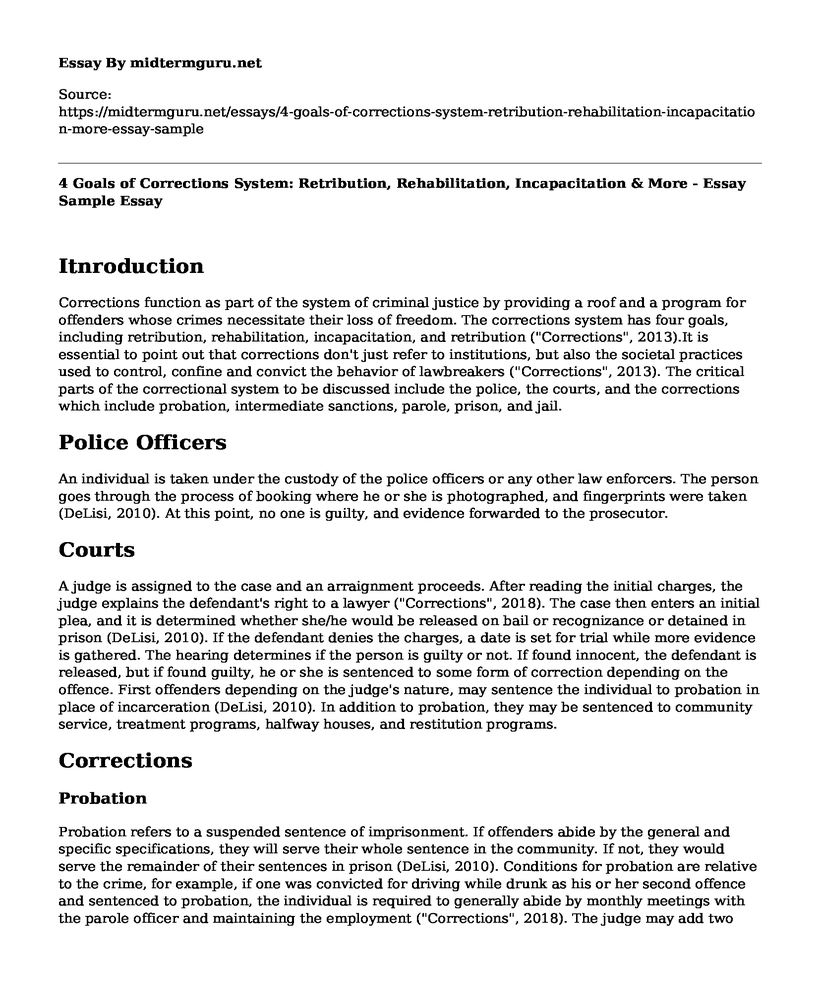Itnroduction
Corrections function as part of the system of criminal justice by providing a roof and a program for offenders whose crimes necessitate their loss of freedom. The corrections system has four goals, including retribution, rehabilitation, incapacitation, and retribution ("Corrections", 2013).It is essential to point out that corrections don't just refer to institutions, but also the societal practices used to control, confine and convict the behavior of lawbreakers ("Corrections", 2013). The critical parts of the correctional system to be discussed include the police, the courts, and the corrections which include probation, intermediate sanctions, parole, prison, and jail.
Police Officers
An individual is taken under the custody of the police officers or any other law enforcers. The person goes through the process of booking where he or she is photographed, and fingerprints were taken (DeLisi, 2010). At this point, no one is guilty, and evidence forwarded to the prosecutor.
Courts
A judge is assigned to the case and an arraignment proceeds. After reading the initial charges, the judge explains the defendant's right to a lawyer ("Corrections", 2018). The case then enters an initial plea, and it is determined whether she/he would be released on bail or recognizance or detained in prison (DeLisi, 2010). If the defendant denies the charges, a date is set for trial while more evidence is gathered. The hearing determines if the person is guilty or not. If found innocent, the defendant is released, but if found guilty, he or she is sentenced to some form of correction depending on the offence. First offenders depending on the judge's nature, may sentence the individual to probation in place of incarceration (DeLisi, 2010). In addition to probation, they may be sentenced to community service, treatment programs, halfway houses, and restitution programs.
Corrections
Probation
Probation refers to a suspended sentence of imprisonment. If offenders abide by the general and specific specifications, they will serve their whole sentence in the community. If not, they would serve the remainder of their sentences in prison (DeLisi, 2010). Conditions for probation are relative to the crime, for example, if one was convicted for driving while drunk as his or her second offence and sentenced to probation, the individual is required to generally abide by monthly meetings with the parole officer and maintaining the employment ("Corrections", 2018). The judge may add two precise conditions, including surrendering the driving license and attending Alcoholics Anonymous meetings once every week. Probation ensures that they continue with school work, use medical care programs available, and maintain social ties in the community.
Intermediate Sanctions
This is a form of punishment that falls between probation and incarceration. They are alternate forms of discipline in the monitoring who are not under the usual probation or incarceration restrictions. They may include home monitoring, fines, and restitution, electronic monitoring, or intensive supervision programs (DeLisi, 2010).
Prison and Jail
Prisons and jails deprive lawbreakers of their freedom. The difference between these two is the inmate's length of stay. Jails are for individuals serving a short sentence or awaiting trial. Prisons, on the other hand, are more developed and are designed to hold inmates convicted for severe crimes. There are different programs, including maximum security, medium or minimum, and solitary confinement (DeLisi, 2010).
Parole
Parole is often used in place of probation, but these two forms of corrections are different. During a probation sentence, a judge suspends an offender's sentence for him or her to serve in the community. On the other hand, a lawbreaker on parole is one who has already served time but is released by the authority in charge of parole, for example, due to good behavior (DeLisi, 2010). It is mandatory to abide by the general and specific conditions just like probation, or face revocation. Most states have parole boards which are given the responsibility to decide when an offender can be conditionally released (DeLisi, 2010).
Conclusion
A correctional system plays a primary role in ensuring that an individual carries out his or her sentence, whether in probation, community service, jail, or prison. Punishing offenders is a way of making them pay a debt to society for their wrongdoing.
References
Corrections. (2013). American Journal Of Health-System Pharmacy, 70(19), 1650-1650. doi: 10.2146/cor130008
Corrections. (2018). American Journal Of Health-System Pharmacy, 75(17), 1264-1264. doi: 10.1093/ajhp/75.17.1264
DeLisi, M. (2010). The criminal justice system works!. Journal Of Criminal Justice, 38(6), 1097-1099. doi: 10.1016/j.jcrimjus.2010.10.003
Cite this page
4 Goals of Corrections System: Retribution, Rehabilitation, Incapacitation & More - Essay Sample. (2023, Jan 24). Retrieved from https://midtermguru.com/essays/4-goals-of-corrections-system-retribution-rehabilitation-incapacitation-more-essay-sample
If you are the original author of this essay and no longer wish to have it published on the midtermguru.com website, please click below to request its removal:
- The Insanity Defense - Essay Sample
- Essay on Discretionary Planning in UK Housing
- Rhetorical Analysis Essay Sample: Farewell Address of Dwight D. Eisenhower
- Essay Sample on Autonomy of Citizens of China and US
- Exploring the Moral Debate on Suicide - Research Paper
- Music & Politics: A Symbiotic Relationship? - Essay Sample
- Attraction and Interpersonal Relationships: Exploring Social Factors - Essay Sample







